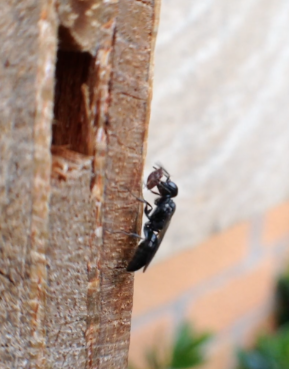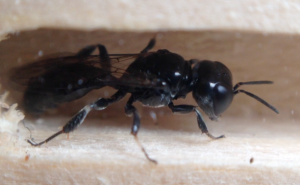Many solitary and social wasps are pest controllers!
Not all wasps sting us! In fact, most do not. They never show any interest in humans whatsoever. Yet they have such a bad name because a few may sting. They prey upon smaller invertebrates. Stinging social wasps and many non-stinging solitary wasps are out and out hunters. Stingers chew their prey to take back to their nest. Many species of solitary wasps paralyse their prey, carry it back to the nest, and store it there for their young to devour later. Others lay an egg on it where they find their prey, whilst others are cuckoos or cleptoparasites. Solitary wasps never see their offspring. Besides being useful pest controllers, they as adults, feed on nectar or honeydew and in search of food may become accidental but important pollinators, e.g. figs and orchids. This film is about 3 wasps that are predators of garden pests.
Solitary wasps are well worth investigating. They are very often overlooked with their bigger cousins, bees getting much more attention. They are ever so interesting and underrated as pest controllers. They are active on sunny warm days, you may find them feeding on nectar on wild carrot or hogweed. The one in the film may be feeding on honeydew or nectar.
At least 3 predatory wasps and several cleptoparasitic wasps have used my garden nest boxes, although sorry, I am not a solitary wasp expert, (who is with approx 9,000 species!!) and certainly do not have the equipment or time to correctly identify them, so I have given a slightly educated and speculative guess as to what they may be. If wrong, please let me know!
Symmorphus bifasciatus
According to BWARS, this species hunts for the larvae of Phratora vulgatissima. (old name Phyllodecta vulgatissima). Both adults and larvae feed on willow leaves and are important pests of willows and poplars. The female wasp paralyses them, stores them inside its nest, and lays an egg inside each cell which is capped with mud with a preliminary mud cap at the end of the cavity, as shown in the video. They are tube nesters using existing cavities. They will nest in plant stems, straws of thatched roofs, vertical sandbanks and vacated burrows of wood-boring insects, which my nest boxes replicate. Looking at the above larvae, they look like likely candidates. There are many willows within 50 yards of my garden.
Passaloecus sp.
Hm, also known as the aphid wasp!! Reading BWARS, it states that this wasp will nest in decayed wood, is reported to supersede other species and will compete for such nests. This one discards aphids and restocks the same nest as seen in the film. According to Yeo & Corbet, the wasp upon finding a colony of aphids, swayed her body and head from side to side repeatedly, as if taking a fix on an individual aphid a few millimetres away, leaping forward to seize the aphid and then returning to her nest. I always thought solitary wasps would paralyse their prey by stinging. Not so in this case. They continue, the wasp squeezes her captured prey around the neck region with her mandibles and after this treatment, the aphids are paralysed; they cannot walk, but remain fresh, with their hearts beating.
They mention that one species of Passaloecus, P. corniger, steals the aphids of other Passaloecus species and there is no evidence that she hunts for herself! She is a sneak burglar who will dart inside a nest site whilst the owner is out, grab an aphid and take it to her nest. Her nest site can even be the nest site of another wasp that she has emptied of aphids! She will even open up a sealed cavity of another wasp in order to steal. Because she steals the aphids of other wasps, she sometimes receives aphids that have already been stolen more than once, so now she is ‘handling stolen goods!’ What a wasp, all going on inside your garden.
Crossocerus sp.
Nest burrows made in deadwood are stocked with small flies for their larvae to devour. Used nest box for resting only. Not a lot of information around about this wasp family!
“All my articles and videos, available free, are funded by my teaching, presentations, sales of award-winning bumblebee nest boxes, solitary bee boxes, and wormeries. Please help by spreading the word and forwarding this link to your friends and colleagues. https://nurturing-nature.co.uk Thank you” George Pilkington
More information
An informative and interesting article “Why we should all love wasps” by Dr Seirian Sumner on Twitter handle @WaspWoman
A great article about the benefits of some wasps!
With another from Dr Andrew Salsibury RHS entomologist
What’s really the point of wasps? By Prof. Adam Hart
You may find this PDF by Tom Ings of BWARS useful, British Social Wasps
Wasps are pollinators and interesting. Help pollinators join Buzz Club
For more information about solitary wasps see BWARS




Recent Comments